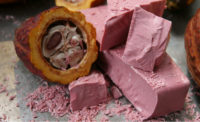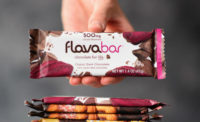Barry Callebaut Group has launched two varieties of chocolate sweetened with cacaofruit as part of its mission to advance cocoa sustainability and drive innovation in the category.
The Swiss chocolate manufacturer revealed WholeFruit chocolate, created with 100 percent cacaofruit and no added sugar, at a special event in San Francisco on Sept. 27. First available to 30 of the world’s top chocolatiers and pastry chefs, other artisans will have access to WholeFruit in May 2020. A wider launch for industrial producers is anticipated in 2021.
Initial offerings include the smooth WholeFruit Velvety, which contains a dairy component, and WholeFruit Bold, which has fruity and bitter notes.
“It has an incredible taste – very fresh, very fruity, very impactful,” Barry Callebaut CEO Antoine de Saint-Affrique told chefs and press members. “It’s made of 100 percent of cacaofruit. It is unleashing the power of Mother Nature and unleashing all the power of that incredible fruit.”
Historically, chocolate producers have purchased and utilized just 30 percent of the cacaofruit – the seeds, also called cocoa beans. The remaining pulp, which surrounds the beans, as well as the juice and husk, are mostly discarded as waste. Some of the pulp aids fermentation, and some of the husks serve as fertilizer, but much of the fruit goes unused, noted Peter Boone, Barry Callebaut president and ceo of the Americas.
“We know what of the peel needs to be there to get the potassium to regenerate the soil; we know what of the pulp needs to be there for fermentation,” he said. “We will definitely look at a balanced way of taking advantage of this, but the truth is, we are throwing away so much of this beautiful product. We are excited we can now make better use of it.”
Barry Callebaut has committed to improving farmers’ livelihoods through its three-year-old Forever Chocolate sustainability initiative. So in addition to reducing waste, repurposing the pulp, juice and husk offers cocoa farmers the opportunity to earn extra income without increasing their yield or farming capacity.
“One of the most important pillars there is to pull farmers out of poverty, to create new value,” Boone said. “We do that on one hand by working them on how to farm, how to set up their farm, but in this way we will also valorize a bigger part of the beautiful product they make.”
Barry Callebaut is launching WholeFruit under the banner of Cacaofruit Experiences, a broader range of ingredient products that will serve a variety of applications, from confectionery and snack to juices and smoothies.
To start, Barry Callebaut is working with cocoa producers in Latin America, but Boone noted eventually Cacaofruit Experiences won’t have regional restrictions. It will take time to extend the program across the company’s 42 source countries, however.
“It is different than making a chocolate,” he said. “Working with the juice, working with the pulp is putting another kind of stress on processing it. Therefore we’re starting out small and scaling it up over time.”
Cacaofruit Experiences succeeds the 2017 launch of Ruby chocolate, a rosy chocolate made with naturally pink cocoa beans. Billed as the fourth type of chocolate after milk, dark and white, Ruby has taken the confectionery world by storm, capturing the attention of artisans and large-scale manufacturers alike.
As a leading player in the cocoa and chocolate sector, Barry Callebaut has set an aggressive timeline for introducing new innovations like Ruby and Cacaofruit Experiences, with a major launch planned every two years.
“If we are not taking a stance and bringing new excitement to the category and the products, we don’t show leadership,” Boone said.
He also pointed to the possibilities in developing products that appeal to Millennials and Generation Z, young consumers who seek great-tasting food that supports their health, their ethics and the environment.
“Food needs to taste amazing just to be a proposition with any future,” Boone said. “The fresh, fruity flavor we bring to all kinds of applications is part of our excitement. At the same time, it’s also nutritious – there’s fiber in there, there’s protein in there, there’s magnesium in there. While enjoying these products, consumers can do something for their health.”
Cacaofruit Experiences has already caught the attention of Mondelez International. Through its innovation hub, SnackFutures, the snacking giant has developed CaPao, a brand focused on utilizing the nontraditional parts of the cacao fruit. Initial product offerings include three varieties of Smoothie Balls and three varieties of Fruit Jerky Strips.
“For us, that’s a very reassuring sign that there is a lot of potential here,” Boone said.
Barry Callebaut isn’t the only chocolate manufacturer seeing the whole cacao fruit with fresh eyes. In July, Nestle SA announced it had created a 70 percent dark chocolate using cacao pulp as a sweetener. It’s set to debut in Japan this fall through its Kit Kat Chocolatory. Further products in other countries will follow next year.







